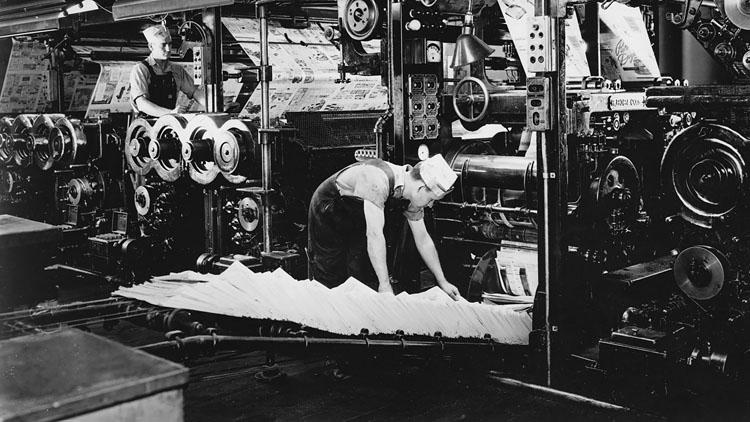Montana in 30 Years: NEWSPAPERS

Dennis Swibold is a longtime professor at the University of Montana’s School of Journalism. He’s a former newspaper editor and reporter and the author of Copper Chorus: Mining, Politics, and the Montana Press, 1889-1959 (Montana Historical Society Press, Helena).
So the year is 2049 and you are ready for the news of the day. In what form did you receive it, and just what does it look like?
I’m 61 now, so in 30 years I’m probably getting it intravenously. Seriously, it’s impossible to know, but I’m guessing news junkies will get fixes constantly and throughout the day from a number of sources, many of which we can’t possibly imagine. I’m already amazed at how omnipresent the news is today. It comes over my phone, computer, TV, car radio, from social media platforms to that quaint stuff we call email, and from several online newspapers.
The need to understand what’s happening down the street or across the world isn’t going to lessen, and I’m confident future technology will bring news in even more ingenious ways. Microchip implants? Google goggles? With everything that’s being tried or talked about, nothing sounds terribly far-fetched.

You have been both a newspaper reporter and an editor. How will employment in the field of journalism evolve over the next 30 years?
I don’t think the demand for news will wane. So, it’s reasonable to assume we’ll need smart people to provide it. Given trends I see, companies are going to get smarter and more sophisticated with marketing and public relations. But so will ordinary people, who I suspect are going to be suspicious of all that. Journalistic values such as verification and transparency will be critical to the credibility of future information providers, no matter for whom or what they work. The newspapers I started my career with were like factories, in which a few people gathered and edited news and photos and dozens of others handled specialties: advertising, production and distribution. I don’t expect that to change in essence, even as the platforms do, though news organizations may replace some people with technology. Future journalism, like everything, will be more data-driven, but recent experience hasn’t convinced me that algorithms do a great job of sifting truth from bunk, not to mention securing users’ data. To the detriment of the news, we’ve already lost too many editors.
Thomas Jefferson viewed newspapers as a peaceable alternative to revolution. Most people would probably agree that newspapers fill a critically important civic responsibility for oversight of democratic institutions. Can our various levels of government function responsibly with limited or no newspaper oversight?
We’ll always need people dedicated to seeking truth and reporting it, especially when it’s inconvenient or unpopular. We’ll always need people committed to serving an audience or a community, instead of just chasing clicks. Governments and other powerful institutions that influence our lives need to be held accountable. Robust, independent news organizations, with the credibility to counter lies and to tell us counterintuitive truths, are essential.

With the advent of “fake news,” how best can newspapers build reader trust and regain their position as reliable and truthful news outlets?
News organizations can rededicate themselves to the values of verification and transparency and work harder to help communities solve real problems—not merely joust at the mirages created by fear-mongers. That won’t be easy because the problem of false information is something everyone needs to address, not just journalists. It’s a problem for scientists, economists—every area of study. Research shows people tend to believe false information if they see it repeatedly, and that politicians who repeat falsehoods will be successful, to some extent. Our echo chambers are Petri dishes for false news. Research also shows flagging something as false doesn’t stop people from sharing it. Better journalism may be part of the answer, but we have to teach information literacy in the schools too. The best way fight false news is to prevent its publication in the first place, but doing that poses big problems in a society that values free expression.

Is it possible that we will see future generations with limited interest in simply “reading” the news?
Readers will exist as long as there’s language, but I’m sure other forms of communication will grow in influence. We may be entering a golden age of good oral storytelling, given the popularity of podcasts, streaming radio, and public storytelling events. Video is booming, and much of it is powerful and moving. Critics have long considered vast swaths of television as wastelands, but much of the visual storytelling we watch in series form is binge-worthy for good reason. Great young songwriters and poets are everywhere. All of these forms have something to teach journalists, the best of whom have always borrowed from the hot forms of the day. Good, true stories can be told in many ways, and its producers will need to be fluent in most of them.
Will newspaper ownership become more or less fragmented in the next 30 years, and what does that mean for the industry?
I think we’ll see the news industry morph in many directions. Some ill-managed news organizations owned are bound to fail. Some innovative and aggressive owners will stake out new ground. As they explore new ways of operating, many will find ways to survive online, though the transformation won’t always be pretty. I believe the news industry—not just newspapers—can adapt to new models of ownership and new formats. Along with failures, we’re seeing bold experiments, and some will succeed. Ironically, we’ve also seen a return to an older style of media ownership, with wealthy individuals buying news organizations large and sometimes small. The quality of those organizations will depend largely on the motives and ethics of their owners—and also how well news fits with their broader business strategies.

What possible path can you see for newspapers to survive or flourish over the coming decades?
It’s a confusing and sometimes painful time, but it’s also an exciting period of experimentation. News has always been subsidized— by subscribers, by related businesses such as commercial printing, and even by public funding models. Now we’re seeing nonprofit or employee-owned models, partnership models and community ownership efforts. One interesting Colorado experiment is banking on blockchain technology to cut transaction costs and increase security for online news vehicles. The subscription/advertising model is likely to remain a part of whatever mix finances the future’s news. My main concern is for community news organizations, especially those that cover smaller places. They’re essential to the social fabric rural America, and those in Montana have fared better than most. I hope they continue, even if forms and formats change.
Finally, describe for us a successful newspaper business model for 2049, if it exists.
It’s difficult to think of just one because communities differ in so many ways. Large ones have advantages of scale, but small ones may be able to build on the amenities or industries that make them unique and still engage a more connected world. Print—ink on paper— isn’t going to disappear. But it may be more of a niche product in the future, part of a multimedia world of enterprising partnerships.












Leave a Comment Here